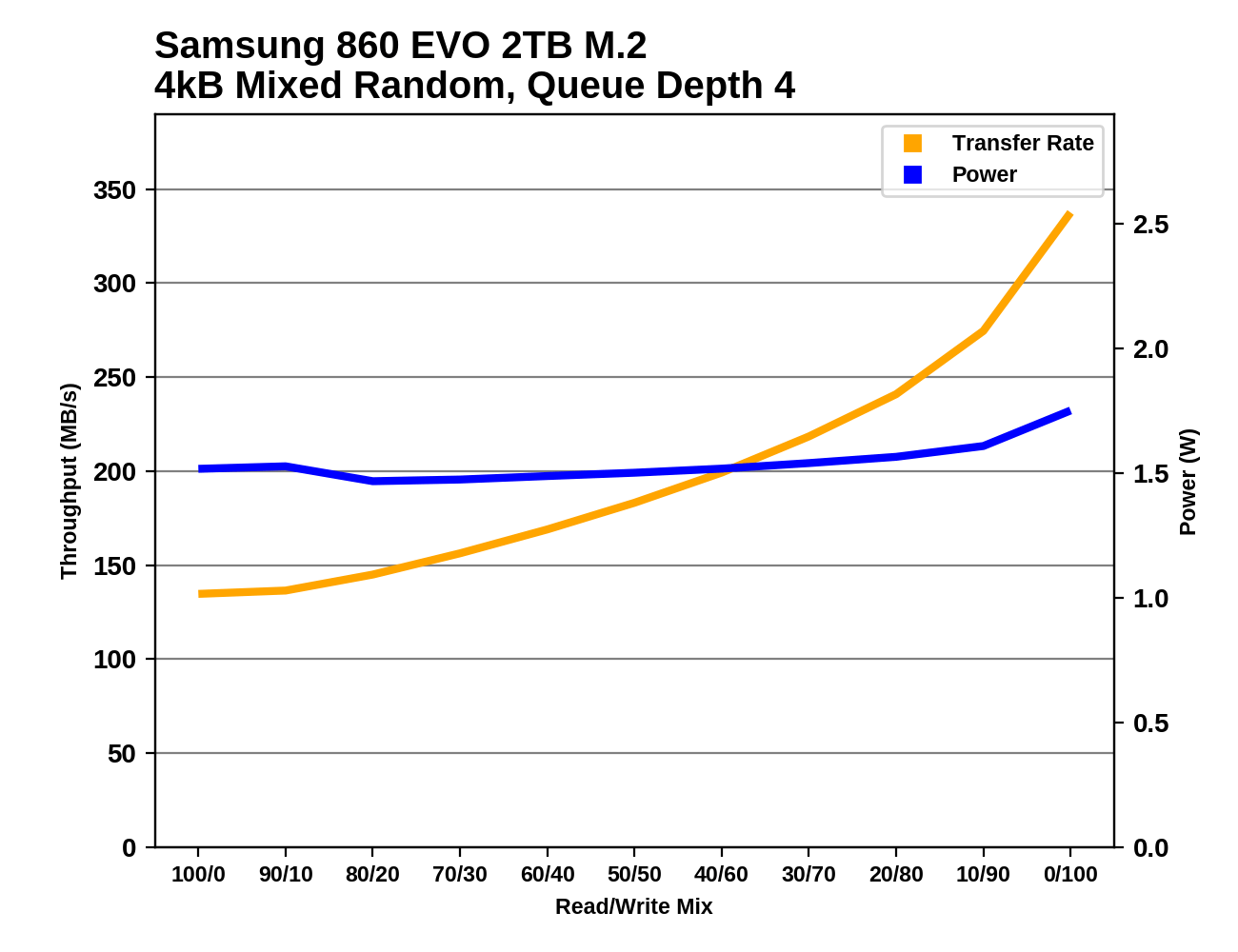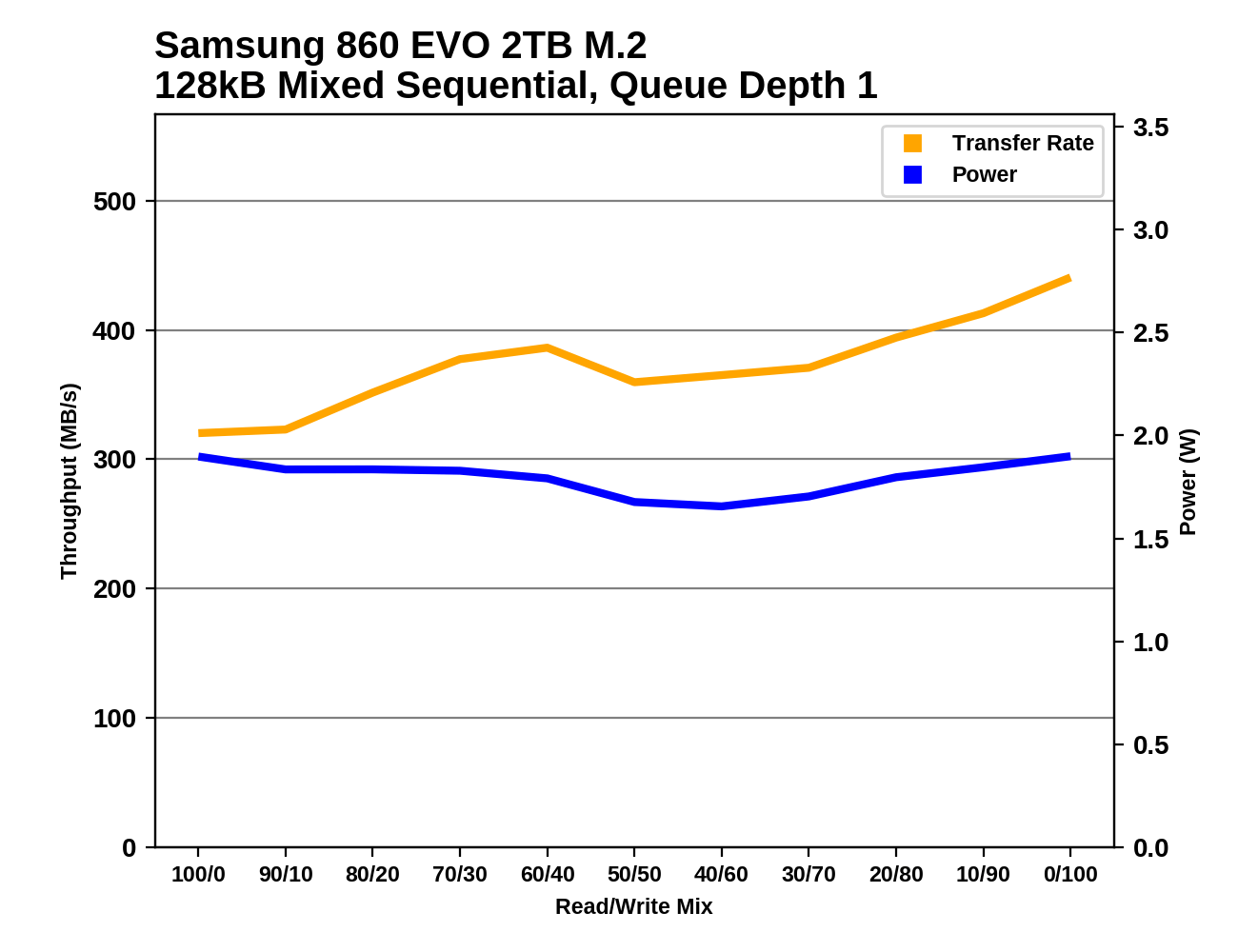The Latest High-Capacity M.2: The Samsung 860 EVO 2TB SSD, Reviewed
by Billy Tallis on February 14, 2018 1:40 PM ESTMixed Random Performance
Our test of mixed random reads and writes covers mixes varying from pure reads to pure writes at 10% increments. Each mix is tested for up to 1 minute or 32GB of data transferred. The test is conducted with a queue depth of 4, and is limited to a 64GB span of the drive. In between each mix, the drive is given idle time of up to one minute so that the overall duty cycle is 50%.

The performance of the Samsung 850 EVO on the mixed random I/O test was still adequate in the face of today's competition, so the large jump in performance the 860 EVO brings gives Samsung a substantial lead over other TLC SATA SSDs

The power efficiency gains of the 860 EVO are even larger than the performance gains; the 860 EVO delivers 33% higher performance per Watt than the next best 64L 3D TLC drive.
 |
|||||||||
The performance of the 860 EVO climbs steadily as the proportion of writes in the test workload increases. The 850 EVO's performance was mostly flat through the first half of the test, and the competition's drives tend to lose a bit of performance somewhere along the way before recovering near the end of the test.
Mixed Sequential Performance
Our test of mixed sequential reads and writes differs from the mixed random I/O test by performing 128kB sequential accesses rather than 4kB accesses at random locations, and the sequential test is conducted at queue depth 1. The range of mixes tested is the same, and the timing and limits on data transfers are also the same as above.

The mixed sequential I/O test shows a bit of a performance regression for the 860 EVO, dropping it slightly below the normal range for good SATA drives. The Crucial MX500 is a bit more of an outlier on the low side.

If it weren't for the 860 PRO, the power efficiency improvement of the 860 EVO over its predecessor would be very impressive. Even overshadowed by its MLC counterpart, the 860 EVO's efficiency is great and well ahead of the competing mainstream SATA SSDs.
 |
|||||||||
Most of Samsung's SATA drives exhibit a bathtub curve for performance, hitting a minimum early in the second half of the test. The 860 EVO gets off to a poor start and actually increases performance through most of the first half of the test as it catches up to the typical Samsung performance curve.










32 Comments
View All Comments
DanNeely - Wednesday, February 14, 2018 - link
Did you do the performance tests via the sata-m2 adapter too? If so will you be re-running them in PCIe mode next?JanW1 - Wednesday, February 14, 2018 - link
This is a M.2 SATA drive, no point in trying to run tests in PCIe mode.Flunk - Thursday, February 15, 2018 - link
I can already tell you the results, they're all 0.Drazick - Wednesday, February 14, 2018 - link
M.2 is perfect for Laptop's.Why don't we see U.2 for Desktop's?
It will mitigate most throttling issues.
Not to say simplify the Mother Boards.
CheapSushi - Thursday, February 15, 2018 - link
There are U.2 for desktops....But U.2 is NVMe/PCIe based. This is SATA/AHCI. You can turn a mini-SAS port and I think U.2 (correct me if wrong) into a quad SATA port with appropriate cable. Nothing wrong with SATA/AHCI for a bulk storage drive. Unless you'e assuming everyone just wants ONE drive for the entire system.BurntMyBacon - Thursday, February 15, 2018 - link
In a system you would want to use the U.2 port in, there is a decent probability that a second drive will be desired if not already present. Like you said, "Nothing wrong with SATA/AHCI for a bulk storage drive". For systems that you can rule out a bulk storage drive, there is a high probability that nVME needs will be served by M.2 rather than U.2.Though some can tell a difference, it is not even certain that most perceive the performance benefit moving from a fast SATA SSD to an nVME SSD for a primary disk due to how current operating systems handle the storage subsystem.
Bulat Ziganshin - Thursday, February 15, 2018 - link
3dnews.ru testing shown that 512 GB model sometimes is slower than 850EVO, due to lower parallelism. It's why Samsung sent you 2TB model for tests insteadyankeeDDL - Thursday, February 15, 2018 - link
Why was the 960 EVO/PRO not included?SpaceRanger - Thursday, February 15, 2018 - link
Because this is a SATA drive, not an NVME drive.Flunk - Thursday, February 15, 2018 - link
As such they utterly destroy this.